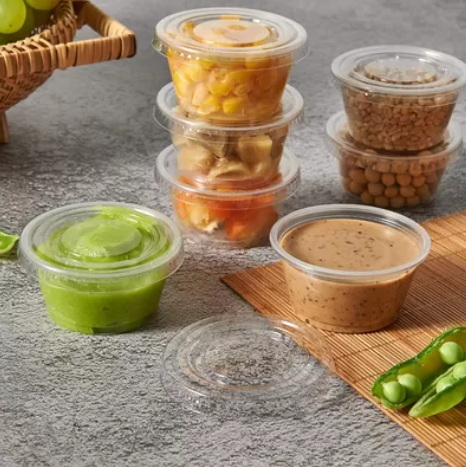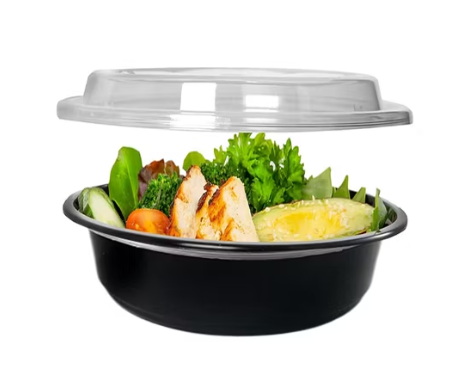
Content Menu
● Introduction to Disposable Plastic Bowls
>> Types of Plastics Used
● Safety Concerns
>> Chemical Leaching
>> Health Risks
● Best Practices for Microwave Use
● Alternatives to Plastic Bowls
● Environmental Impact
● Consumer Awareness
● Future Developments
● Impact on Food Quality
● Economic Considerations
● Regulatory Framework
● Conclusion
● Frequently Asked Questions
>> 1. What Types of Plastics Are Safe for Microwave Use?
>> 2. Can All Disposable Plastic Bowls Be Microwaved?
>> 3. What Are the Health Risks of Microwaving Food in Plastic?
>> 4. How Can I Ensure Safe Microwave Use of Plastic Bowls?
>> 5. What Are Some Alternatives to Plastic Bowls for Microwaving?
In today's fast-paced world, convenience is key, and disposable plastic bowls with lids have become a staple in many households and businesses. They are lightweight, affordable, and easy to use for both hot and cold foods. However, the safety of microwaving these bowls has raised concerns among consumers. This article aims to delve into the safety aspects of using disposable plastic bowls with lids in microwaves, exploring the types of plastics used, potential health risks, and best practices for safe microwave use.

Introduction to Disposable Plastic Bowls
Disposable plastic bowls are made from various types of plastics, with polypropylene (PP) and polystyrene (PS) being common materials. Polypropylene is generally considered safe for microwave use due to its high melting point and resistance to chemical leaching. On the other hand, polystyrene is not recommended for microwaving as it can melt and release harmful chemicals.
Types of Plastics Used
- Polypropylene (PP): Marked with the resin identification code "5," PP is a thermoplastic known for its durability and resistance to heat. It is commonly used in microwave-safe containers and is considered safe for reheating food.
- Polystyrene (PS): Identified by the code "6," PS is not suitable for microwave use. It can melt and release chemicals like styrene, which is a potential health concern.
Safety Concerns
The primary concern with microwaving plastic bowls is the potential for chemicals to leach into food. This risk is higher with certain types of plastics and when heating fatty or oily foods.
Chemical Leaching
Chemicals like Bisphenol A (BPA) and phthalates are found in some plastics and can act as endocrine disruptors. However, microwave-safe plastics are designed to minimize this risk. The FDA regulates the use of plastics in food packaging to ensure safety.
Microwaving plastic can accelerate the release of harmful chemicals like BPA and phthalates into food. Even BPA-free plastics can release other hormone-disrupting chemicals like bisphenol S and F (BPS and BPF) when heated. Therefore, it's crucial to only use containers labeled as "microwave-safe."
Health Risks
While there is some concern about the health impacts of microwaving food in plastic, the scientific consensus is that microwave-safe plastics pose a minimal risk. However, it's always best to err on the side of caution, especially with children's food. Many of the chemicals that leach out of plastics into food are endocrine disruptors, which can disrupt hormonal signals in the body, potentially leading to issues like obesity, diabetes, and certain cancers.
Best Practices for Microwave Use
To ensure safe microwave use of disposable plastic bowls, follow these guidelines:
1. Choose Microwave-Safe Containers: Always select bowls labeled as "microwave-safe." Look for the microwave symbol or the resin identification code "5" for polypropylene.
2. Avoid Overheating: Use moderate power settings and heat food in short intervals to prevent excessive heat buildup.
3. Vent the Container: Ensure the lid is slightly ajar to allow steam to escape and prevent pressure buildup.
4. Discard Damaged Containers: Never use cracked, warped, or discolored plastic bowls as they can leach harmful chemicals.
5. Avoid Fatty Foods: Heating fatty or oily foods in plastic containers increases the risk of chemical leaching. It's best to avoid microwaving these types of foods in plastic.

Alternatives to Plastic Bowls
For those concerned about the safety of plastic, there are several alternatives available:
- Glass Containers: Inert and non-reactive, glass is an excellent choice for microwaving. It does not leach chemicals and is eco-friendly.
- Ceramic Containers: Similar to glass, ceramic is safe for microwave use and does not react with food.
- Paperboard Bowls: A more eco-friendly option, paperboard bowls are suitable for soups and salads. They are often lined with a thin layer of plastic to prevent leaks.
Environmental Impact
The use of disposable plastic bowls also raises environmental concerns. Plastic waste contributes significantly to pollution and the degradation of ecosystems. Choosing reusable alternatives like glass or ceramic can help reduce plastic waste and promote sustainability. Additionally, recycling plastic waste is crucial to minimize its environmental impact. Many communities have implemented recycling programs for plastics, which can help reduce landfill waste and conserve natural resources.
Consumer Awareness
Raising awareness about the safety and environmental impact of disposable plastic bowls is crucial. Consumers should be informed about the risks associated with microwaving certain plastics and the benefits of using eco-friendly alternatives. This awareness can lead to better choices in kitchenware and contribute to a more sustainable lifestyle. Educational campaigns and labeling regulations can help ensure that consumers make informed decisions.
Future Developments
As technology advances, there may be new materials developed that are safer and more environmentally friendly than current plastics. Innovations in bioplastics and compostable materials could offer alternatives that minimize both health risks and environmental impact. Bioplastics, derived from renewable biomass sources, are biodegradable and can reduce dependence on fossil fuels. Compostable plastics, made from materials like corn starch or sugarcane, can easily decompose and return to nature without harming the environment.
Impact on Food Quality
Microwaving food in plastic can also affect its quality. Chemicals from the plastic can impart flavors or odors to the food, altering its taste and texture. This is particularly noticeable with acidic or fatty foods, which can extract more chemicals from the plastic. Using glass or ceramic containers can help preserve the flavor and nutritional value of food.
Economic Considerations
While disposable plastic bowls are affordable and convenient, the long-term costs of their use should be considered. The environmental and health impacts of plastic waste can lead to significant economic burdens, including cleanup efforts and healthcare costs. Investing in reusable containers may seem more expensive upfront but can save money in the long run by reducing waste and promoting sustainability.
Regulatory Framework
Regulations play a crucial role in ensuring the safety of plastic products. The FDA and other regulatory bodies set standards for the use of plastics in food packaging. These standards help ensure that only safe plastics are used in microwave-safe containers. However, there is always room for improvement, and ongoing research is needed to update these standards as new information becomes available.
Conclusion
Disposable plastic bowls with lids can be used in microwaves if they are labeled as "microwave-safe" and made from appropriate materials like polypropylene. While there are some health concerns associated with microwaving plastics, following best practices and choosing the right type of plastic can minimize risks. For optimal safety, consider using glass or ceramic containers.

Frequently Asked Questions
1. What Types of Plastics Are Safe for Microwave Use?
Plastics marked with the resin identification code "5" and labeled as "PP" (polypropylene) are generally considered safe for microwave use. Always check for the microwave-safe symbol on the container.
2. Can All Disposable Plastic Bowls Be Microwaved?
No, not all disposable plastic bowls are safe for microwaving. Only those specifically labeled as "microwave-safe" should be used. Avoid microwaving single-use plastics or those made from polystyrene (PS).
3. What Are the Health Risks of Microwaving Food in Plastic?
While microwave-safe plastics are designed to minimize chemical leaching, there is still a risk of exposure to harmful chemicals like BPA and phthalates. This risk is higher with certain types of plastics and when heating fatty foods.
4. How Can I Ensure Safe Microwave Use of Plastic Bowls?
To ensure safety, use microwave-safe containers, avoid overheating, vent the container, and discard damaged bowls. Always follow the manufacturer's guidelines.
5. What Are Some Alternatives to Plastic Bowls for Microwaving?
Alternatives include glass, ceramic, and paperboard bowls. These materials are safer and more eco-friendly than plastic.

















